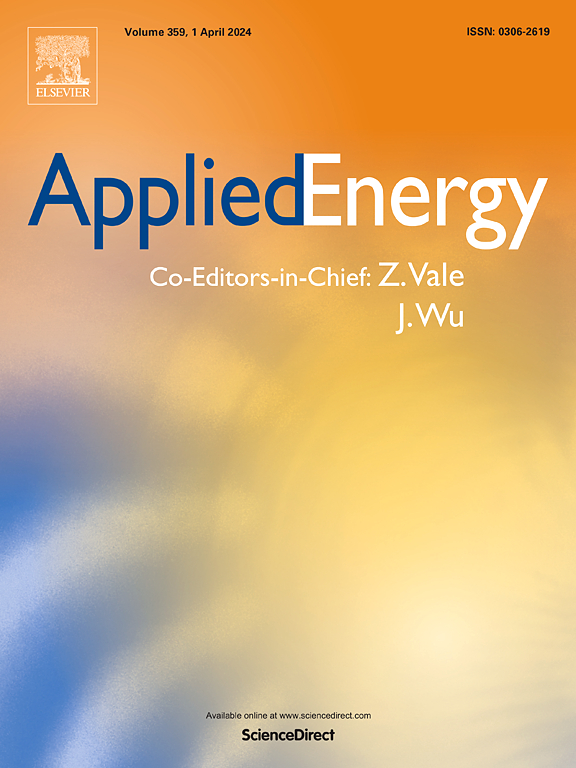Techno-economic feasibility study of imported green hydrogen via inter-continental route: From Australia to South Korea
IF 11
1区 工程技术
Q1 ENERGY & FUELS
引用次数: 0
Abstract
Green hydrogen is crucial for South Korea’s low-carbon transition. However, due to limited domestic production capacity, importing hydrogen from countries with abundant renewable energy resources, such as Australia, is essential. This study develops a model to evaluate the techno-economic feasibility of importing green hydrogen from Australia. The analysis considers importing stages, including hydrogenation, shipping, port, dehydrogenation, and inland distribution, evaluating multiple pathways with, liquid hydrogen and ammonia carriers, and various transportation methods. The results demonstrate that ammonia (USD 3.345–8.008 kg-H2−1) is a more economically viable hydrogen carrier compared to liquid hydrogen (USD 6.456–10.656 kg-H2−1). Furthermore, importing costs are projected to decline by approximately 12.5 %–37.3 % by 2030, aligning with South Korea’s national hydrogen technology development targets. The study also finds that even under a global carbon price scenario of up to USD 200 ton-CO2−1, carbon-free ships struggle to achieve cost parity with fossil-fueled ships. Achieving cost parity for carbon-free ships by 2040 would specifically require a carbon price approximately 38.5 % higher than this maximum scenario. For inland transportation, battery-electric vehicles become economically favorable at carbon prices up to USD 86 ton-CO2−1. This research also emphasizes the need for strategic investments in energy-efficient ammonia cracking technologies, clean transportation methods such as battery-electric vehicles and ammonia-powered ships, and comprehensive hydrogen supply planning to enable a cost-effective, low-carbon economy. It additionally highlights the importance of embedding carbon pricing within the hydrogen import process.
通过洲际路线进口绿色氢的技术经济可行性研究:从澳大利亚到韩国
绿色氢对韩国的低碳转型至关重要。然而,由于国内生产能力有限,从澳大利亚等拥有丰富可再生能源的国家进口氢气是必不可少的。本研究建立一个模型来评估从澳洲进口绿色氢的技术经济可行性。分析考虑了加氢、海运、港口、脱氢、内陆配送等进口阶段,评估了液氢和氨载体的多种途径,以及各种运输方式。结果表明,与液氢(6.456 ~ 10.656 kg-H2−1)相比,氨(3.345 ~ 8.008 kg-H2−1)是更经济可行的氢载体。此外,到2030年,进口成本预计将下降约12.5 % -37.3 %,与韩国国家氢技术发展目标保持一致。该研究还发现,即使在全球碳价格高达200美元 吨二氧化碳−1的情况下,无碳船舶也难以实现与化石燃料船舶的成本平价。到2040年实现无碳船舶的成本平价,具体要求碳价比这一最高情景高出约38.5% %。对于内陆运输,电池电动汽车在碳价格高达86美元 吨二氧化碳−1的情况下具有经济优势。该研究还强调了对节能氨裂解技术、清洁运输方式(如电池电动汽车和氨动力船舶)以及全面的氢供应规划进行战略投资的必要性,以实现具有成本效益的低碳经济。它还强调了将碳定价纳入氢进口过程的重要性。
本文章由计算机程序翻译,如有差异,请以英文原文为准。
求助全文
约1分钟内获得全文
求助全文
来源期刊

Applied Energy
工程技术-工程:化工
CiteScore
21.20
自引率
10.70%
发文量
1830
审稿时长
41 days
期刊介绍:
Applied Energy serves as a platform for sharing innovations, research, development, and demonstrations in energy conversion, conservation, and sustainable energy systems. The journal covers topics such as optimal energy resource use, environmental pollutant mitigation, and energy process analysis. It welcomes original papers, review articles, technical notes, and letters to the editor. Authors are encouraged to submit manuscripts that bridge the gap between research, development, and implementation. The journal addresses a wide spectrum of topics, including fossil and renewable energy technologies, energy economics, and environmental impacts. Applied Energy also explores modeling and forecasting, conservation strategies, and the social and economic implications of energy policies, including climate change mitigation. It is complemented by the open-access journal Advances in Applied Energy.
 求助内容:
求助内容: 应助结果提醒方式:
应助结果提醒方式:


